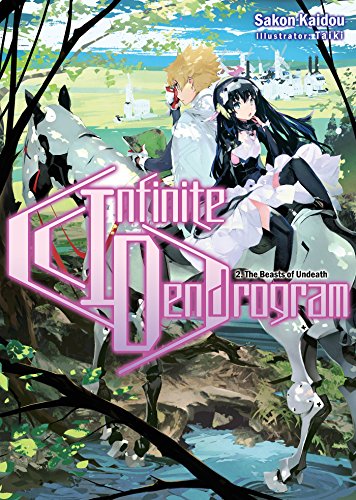By Sakon Kaidou and Taiki. Released in Japan by Hobby Japan. Released in North America by J-Novel Club. Translated by Andrew Hodgson.
Much as people criticize the warnings on the back of manga noting when there is sex, nudity or violence, sometimes I do think it’s worth telling people in advance, particularly if it’s something that would upset a fairly significant chunk of the audience. So let’s get that out of the way first. This second volume of Infinite Dendrogram contains multiple grotesque and graphic murders of children – in fact, for the first half or so, child kidnapping and murder is the plot. It reaches his zenith when Ray and Nemesis come across skeletons and zombies with the remaining souls of the murdered children inside, and have to destroy them all to move on. This ties in with the main theme of the book, which I’ll get to in a bit, but boy howdy could I have used a warning. So, warning: LOTS OF MURDERED CHILDREN.
That said, of course, they’re not ‘real’ children, but ones designed by the game developers. I spoke before about the fact that Dendrogram is about the only light novel around that has a normal hero playing a game without getting caught in it, or the game being the actual fantasy world, or any one of a thousand other light novel game tropes. Ray still has to log out and eat/sleep, though that’s given somewhat short shrift here. And this means that we the reader view this as a game a bit more than we do in, say, Sword Art Online. Ray’s death means that the quest may not be completed, and some NPCs may suffer, but it doesn’t mean his actual death. As a result, Ray and his new friend Hugo find that no one has actually tried to stop the child murder scheme because it would be a pain in the ass to fix and likely not worth the cost. That said, Ray (and Hugo, it turns out) are of a different stripe. The “maiden” support they have, in the form of Nemesis and Hugo’s companion, means they are “too caught up” in the story. They’re the sort who would rescue the doomed children in a game, even for little reward and high difficulty, because it’s morally heinous.
Ray is helped along here by his brother, whose actions we helpfully see in a flashback. Ray’s brother hasn’t done much in the series besides introduce him to the game and make bear puns, but we see that he is definitely “the protagonist of another story”, as he gets a grievous injury right before a martial arts match, then goes on to win it anyway through the sheer power of GUTS! I take that back, he’s not the hero of another story, he’s the cool mentor who gets killed off midway through – ominous sign. But it does also signpost why Ray acts the way he does, and why he comes to the conclusion that it’s OK to treat the NPCs as real people. Admittedly, his main concerns may need to be the other players – the final scene in the book reminds us that there are various sections of the map all poised to wipe out Ray’s section, in a very ‘Horde vs’ Alliance’ sort of way.
Dendrogram is well-written, with a likeable hero, and I’ve even gotten over the underage pimp and his PG-rated pimp squad. It’s worth a read, but I have to admit the main thing I took away from it was “wow, that was some graphic child murder description I did not need”.

